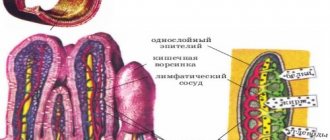Why does blood appear in stool?
Blood from the anus appears due to a violation of the integrity of medium or large vessels in some area of the gastrointestinal tract.
The digestive canal has a lot of blood vessels, which ensures that nutrients quickly enter the blood. Poor nutrition and infections lead to the formation of various pathologies in which blood vessels are injured.
Diagnosis and treatment
In proctology, various methods are used to help determine what caused bleeding from the anus:
- Analysis of stool, which makes it possible to detect blood, even if it is not visible visually, is prescribed in cases where the doctor suspects the patient has a disease, the symptom of which is rectal bleeding.
- Irrigoscopy – to carry it out, a special substance is injected into the intestines, which is necessary to obtain a clear image on an x-ray.
- Gastroduodenoscopy is an examination of the patient using an endoscope, which allows one to assess the condition of the mucous membrane of the digestive organs. Sometimes this method is used to treat - cauterization - ulcers.
- Rectoscopy - with its help, the human digestive system is examined, and more specifically, its lower sections. With this method, doctors can identify hemorrhoids, anal fissures, and various formations in the sigmoid and/or rectum.
- Colonoscopy is nothing more than a more extensive rectoscopy. It is carried out endoscopically and allows you to detect all changes that have occurred in the structure of the large intestine.
There can be many reasons for the discharge of blood from the anus in men and women. Only a specialist can install and remove them. And if after some time the release of blood during bowel movements stops, this does not mean that the cause of its occurrence has disappeared.
You need to take this problem very seriously, even if you suspect what caused the disorder. There are a number of diseases that can cause blood to appear after bowel movements.
Nature of the discharge
Blood may differ in color depending on the cause and location of the lesion in the gastrointestinal tract.
| Character of bloody discharge | Presumable location of the lesion in the gastrointestinal tract | probable reasons |
| bright red | sigmoid or rectum | anal fissures, hemorrhoids, colon cancer, polyps |
| dark red, wine color | small intestine | cancer, polyps |
| black resinous with odor | stomach, upper part of the small intestine | diverticulum |
| clots or veins | lower part of the digestive tract | colitis |
Sometimes blood cannot be seen with the naked eye and is detected through stool testing. Such bleeding is called occult. They are caused by the same factors as rectal.
Bloody feces: associated symptoms
The nature and intensity of bleeding depends on the disease causing it. The main difficulty is that many pathological processes in the initial stages are asymptomatic.
To avoid the disease becoming severe, you should pay attention to the following manifestations:
- pain, burning in the stomach after eating;
- dyspeptic disorders: heaviness in the abdomen, flatulence;
- diarrhea and constipation;
- loss of appetite;
- itching in the anus;
- general weakness.
Most diseases have a similar clinical picture. Only a doctor can make an accurate diagnosis. A description of the symptoms is not enough for this; a comprehensive examination is necessary.
Be sure to read: How to quickly cure hemorrhoids: 2 effective methods + therapy at home
Internal bleeding with gastritis
Chronic diseases of the gastrointestinal tract often cause bleeding into the internal organs or the retroperitoneal cavity. Diseases that can provoke hemorrhage are: malignant tumors, gastric ulcer, erosive gastritis, esophageal varices.
A number of signs can be identified that are characteristic of all types of bleeding in the early stages - general weakness; drowsiness; dizziness; cold sweat; pallor of the skin and mucous membranes; darkening of the eyes; thirst.
With low blood loss, there is often a slight increase in heart rate and a slight decrease in blood pressure. However, such internal bleeding may sometimes not be accompanied by any symptoms at all.
Chronic diseases of the gastrointestinal tract often cause bleeding into the internal organs or retroperitoneal cavity
With moderate internal bleeding, systolic pressure drops to 80-90 mmHg. Art., the pulse quickens to 90-100 beats per minute. The skin becomes pale, the extremities become cold, and increased breathing may occur. Also in such a situation, dry mouth, fainting and dizziness, adynamia, nausea, slow reaction, and weakness are possible.
In severe cases, systolic pressure drops to 80 mmHg. Art. and even lower, the pulse increases to 110 beats per minute and above. Sticky cold sweat appears on the body, there is a strong increase in breathing, yawning, nausea and vomiting, apathy, hand tremors, increased drowsiness, painful thirst, a decrease in the amount of urine excreted, severe pallor of the skin and mucous membranes.
With massive internal bleeding, systolic pressure drops to 60 mmHg. Art., the pulse rate can reach 140-160 beats per minute. Characteristic features of massive internal bleeding are periodic breathing (Cheyne-Stokes breathing), delirium, confusion or lack thereof, cold sweat, severe pale skin. The gaze becomes indifferent, the facial features become sharpened, the eyes become sunken.
In case of fatal blood loss
systolic pressure decreases to 60 mm Hg. Art. or is not determined at all. Coma develops, breathing becomes agonal, severe bradycardia, convulsions, dilated pupils, and involuntary release of feces and urine are observed. The skin becomes dry and cold, acquiring a characteristic “marble” shade.
Signs of internal bleeding also depend on which cavity the blood is bleeding into. For example, nausea and vomiting of dark blood may indicate bleeding into the cavity of the stomach or esophagus; coughing with bright pulmonary blood is an unambiguous sign of pulmonary hemorrhage.
Emergency care for internal bleeding depends on which body cavity the blood is bleeding into. If there is a suspicion of pulmonary hemorrhage, the patient should be given a semi-sitting position; in other cases, he should be laid on a flat surface. During this time, the patient should under no circumstances drink or eat or take medications until specifically instructed by the doctor. It is extremely important to get him to a specialist care unit as quickly as possible.
Common Causes of Blood in Stool
There is a wide range of diseases and factors that can cause or worsen rectal bleeding.
| Group of diseases | Pathologies | Pathogenesis |
| Violation of the integrity of the rectal mucosa | Anal fissures – tears in the anal mucosa | Cause bleeding and burning pain after bowel movements. Cracks occur with frequent constipation caused by abuse of mono-diets; they are also observed during pregnancy. |
| Pathologies of the venous system, local circulation disorders | Hemorrhoids are a collection of tissue in the anal canal containing many blood vessels. | As hemorrhoids enlarge, they become more susceptible to injury, primarily from passing feces. |
| Angiodysplasia of the colon - dilation and deformation of the vessels of the colon. | The walls of the blood vessels are so fragile that the passage of feces leads to their rupture. | |
| Gastrointestinal diseases | Diverticulum is an inflammation of the intestines with the appearance of small pouches (diverticulum). | When diverticula rupture, blood leaks from the anus. |
| Stomach ulcer – ulceration of the gastric mucosa. | Ulcers disrupt motility and pH of the gastrointestinal tract. The disease causes bloody diarrhea. | |
| Benign neoplasms | Villous polyps are benign growths of the colon epithelium. | The appearance of blood is preceded by mucous discharge and painful bowel movements. |
| Oncology | Colorectal cancer is a malignant tumor of the lower digestive tract. | Blood is not always detected visually. |
| Rectal cancer is a malignant neoplasia (tumor) of the final section of the intestine. | Bleeding is preceded by intestinal obstruction, heartburn, and flatulence. | |
| Infectious lesions | Dysentery is damage to the intestinal mucosa by bacteria of the genus Shigella. | Bacteria penetrate the mucosa, causing inflammation, erosion, which leads to hemorrhages. |
| Rectal fistulas are deep canals between the rectum and the skin around the anus. | Fistulas (fistulas) cause itching, and pus appears on the underwear before the bloody discharge. | |
| Infectious colitis is an inflammation of the large intestine caused by pathogenic flora. | The growth of bacteria contributes to the development of diarrhea, the appearance of mucus, in which streaks of blood are found. |
The causes of blood in the stool are usually the same in men and women. But some diseases, the symptom of which is bleeding, are more often diagnosed in representatives of a certain gender. Although experts believe that statistics do not show the real prevalence of the pathology, but reflect the detection rate.
Be sure to read:
The first signs of hemorrhoids in men: internal and external symptoms, the best treatment methods
Causes of blood in the stool in men
Due to anatomical features, some diseases that cause rectal bleeding are more common in men than in women. One of these diseases is radiation proctitis - an inflammatory process in the rectum caused by radiation therapy for pelvic cancer, most often prostate cancer.
The cause of bleeding is not only radiation exposure.
- Failure to follow a diet and limited consumption of liquid foods (soups) lead to disruption of the gastrointestinal tract.
- Reduced physical activity. Sedentary work leads to poor circulation in the pelvic area, contributing to the development of hemorrhoids.
- Chronic prostatitis. The source of inflammation quickly spreads to organs adjacent to the prostate, in particular to the rectum, causing a violation of the integrity of the mucous membrane.
In men, oncology of the gastrointestinal tract is diagnosed more often than in women.
Why does blood appear in women's stool?
Bleeding from the anus in women is caused by the same pathologies as in men.
A number of factors contribute to their occurrence:
- Abuse of diets. With a poor diet, gastric juice eats away the mucous membrane, and ulcers develop.
- Pregnancy. In the latter stages, due to the increase in the size of the uterus, blood circulation in the anal canal is disrupted, and venous accumulations - hemorrhoids - form.
- Peritoneal endometriosis. With the pathological proliferation of endometrial cells of the ovaries, fallopian tubes, and cervix, the blood supply to neighboring pelvic organs is disrupted. Adhesions in the abdominal organs lead to disruption of their functioning. Pathologies arise, one of the symptoms of which is rectal bleeding.
Fistulas in women can be the result of birth injuries or gynecological interventions.
Erosive gastritis bleeding
Gastritis is a common disease associated with inflammation of the gastric mucosa. With erosive, or hemorrhagic, gastritis, the mucous membrane not only becomes inflamed, but begins to wear off, and bleeding (erosion) occurs. Erosive gastritis develops slowly; at first, a person usually ignores its symptoms. Therefore, the disease affects a large part of the gastric mucosa.
Erosive gastritis is also called stress gastritis, since the disease often occurs suddenly, due to injury, illness or nervous strain. Like regular gastritis, erosive gastritis can be acute or chronic. Acute erosive gastritis develops quickly, especially if accompanied by stress. The chronic form is characterized by multiple erosions on the gastric mucosa.
Erosive gastritis can occur with any acidity. The pain with it is much more intense than with other forms of gastritis, and is often associated with food intake. A complication is gastric bleeding. The diagnosis can only be made by gastroscopy. Chronic erosive gastritis often occurs with almost no alarming symptoms.
Symptoms of erosive gastritis:
- acute abdominal pain immediately after eating or on an empty stomach;
- blood clots in vomit;
- dark, tar-like feces.
With erosive or hemorrhagic gastritis, the mucous membrane not only becomes inflamed, but begins to wear off and bleeding occurs
. If treatment is not started in time, erosive gastritis can provoke dangerous complications. Among them are severe internal bleeding, stomach and duodenal ulcers, and in especially severe cases, stomach cancer. Against the background of gastritis, a general aversion to food by the body may develop, resulting in vitamin deficiency, excessive thinness, heartburn, and frequent vomiting.
Treatment of bleeding with gastritis
Treatment of the disease is usually conservative; surgical treatment of erosive gastritis is resorted to only in particularly severe cases. Diet for erosive gastritis is an essential condition for a speedy recovery.
Drug treatment of erosive gastritis is implemented in two main areas:
- eradication (destruction) of Helicobacter pylori;
- eliminating the impact of aggressive factors, relieving symptoms, stimulating the healing processes of the gastric mucosa.
In addition to pharmacotherapeutic treatment of erosive gastritis, complex therapy in the presence of bleeding can include thermo- or electrocoagulation, laser coagulation, staples, endoscopic stitching, injections of adrenaline, sclerosants.
Sources:
- https://yellmed.ru/bolezni/zheludochnoe-krovotechenie
- https://doctorpiter.ru/diseases/363/
- https://www.vidal.ru/encyclopedia/gastroenterologiya/erozivnyy-gastrit-zheludka
- https://p-87.ru/health/erozivnyj-gastrit/
- https://illness.docdoc.ru/vnutrennee_krovotechenie
What to do if blood is found in the stool?
The presence of blood in the toilet or on toilet paper after bowel movements is an alarming symptom. Any pathology begins with insignificant, for a non-specialist, manifestations. When an unpleasant phenomenon is detected, a person needs to remember whether there have been any injuries to the anus, whether going to the toilet is accompanied by painful sensations.
If bleeding is accompanied by pain, you should not take anti-inflammatory drugs until the cause is determined. Most NSAIDs contain acetylsalicylic acid, which has a negative effect on the intestines.
Blood in the stool is a dangerous symptom, regardless of its severity and the presence or absence of additional pathological manifestations, you must consult a doctor.
Be sure to read:
How to remove hemorrhoids: symptoms and treatment of external and internal nodes
Latent blood
Hidden blood in stool can only be determined by microscopy. The most common cause is tumor disintegration. Stool analysis is carried out in the following cases:
- the presence of foam with bloody streaks in the stool;
- discomfort, pain during bowel movements;
- loss of 10% of the patient’s initial weight;
- hyperthermia of unknown origin;
- the structure of feces changing from day to day.
The cause of pathology in children can be the proliferation of pathogenic microbes in anal fissures, lactose intolerance, and allergies to food dyes. In addition, this condition indicates the onset of inflammatory processes.
Diagnostics
The origin of rectal bleeding is determined using anamnesis, physical examination, laboratory and other types of examinations.
Types of studies prescribed by a doctor for anal bleeding:
- colonoscopy;
- contrast radiography;
- angiography;
- stool examination for occult blood;
- coprogram;
- stool culture tank;
- general blood test with determination of the number of red blood cells and hemoglobin;
- tests for infections;
- tumor markers.
The doctor may order additional studies as part of the differential diagnosis of certain pathologies.
Methods for treating rectal bleeding
Therapy is determined by a proctologist or gastroenterologist based on the symptom complex and the causes of bleeding.
The doctor may use one or more methods, including:
- Symptomatic therapy. Painkillers and antidiarrheals are prescribed.
- Diet correction , increasing the diet of foods high in iron.
- Taking medications : antibiotics, anti-inflammatory, hemostatic agents.
- For neoplasms, surgical intervention .
- Oncology treatment includes radiotherapy and chemotherapy .
Acute bleeding is treated with endoscopy. The damaged area is cauterized with a laser and coagulating drugs are administered.
Blood during bowel movements in women
Specific reasons for the appearance of blood in the stool in women are related to the physiology of the female body:
- Varicose veins of the perineum during the last trimester of pregnancy;
- Intestinal endometriosis;
- Side effects of radiation therapy for cancer of the reproductive organs.
At the end of pregnancy, the growing uterus exerts a mechanical effect on the pelvic organs and peritoneum. The lower intestines and genitals are supplied with blood more intensively than usual, its coagulability is slightly reduced within the physiological norm for the development of pregnancy. Therefore, when defecation is accompanied by constipation, blood in the stool is occasionally possible. If it worsens, you should seek medical help to differentiate it from vaginal bleeding. Preventing the appearance of blood during bowel movements - introducing foods with plant fiber into the diet, using soft toilet paper.
When a woman has endometriosis, cells that function similarly to the cells of the endometrial lining of the uterus spread in various organs. They are carried in the flow of lymph or blood. During menstruation, endometriosis lesions bleed. If a woman is diagnosed with intestinal endometriosis, the cells will produce blood with mucus. Most often, its amount is minimal; pathology is detected only when testing for occult blood, and only during menstruation.
Possible complications - with large lesions, intestinal obstruction and stenosis are possible. Treatment is hormonal therapy.
Radiation colitis may be a complication of radiation therapy. Its symptoms are alternating diarrhea and constipation, the appearance of mucus and blood in the stool. Treatment is symptomatic; over time, regeneration of the mucous membrane occurs.
Preventing blood in stool
Prevention should be aimed at preventing the development of pathologies that cause anal bleeding:
- Dieting.
- Regular walks, exercise.
- Proper anal hygiene.
- Avoiding trauma to the rectum.
- Regular examinations by a proctologist.
Blood in the stool should not be ignored. It can be a symptom of a serious illness; the earlier the diagnosis is made, the greater the chance of recovery.
In continuation of the topic, be sure to read:
- Details about the coprogram: preparation, conduct and interpretation of the analysis
- Rectal cancer: symptoms, stages, treatment and prognosis for life
- More about hemorrhoids: causes, symptoms and treatment methods
- Rectal fissure: causes, symptoms and treatment of pathology
- Signs of gastrointestinal bleeding and assistance to the patient
- Irritable bowel syndrome: symptoms and treatments
- Undigested food in a child’s stool: why does it appear and what does it mean?
- Mucus in a child’s stool: causes and what to do?
- Why and what causes my stomach to growl, what to do?
- Undigested food in the feces (lientorrhea) in an adult: causes and diagnosis of pathologies











